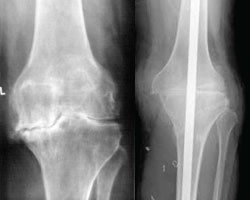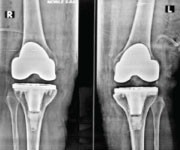Osteotomy -
Osteotomy is the correction of bone deformity by cutting and repositioning the bone, then resetting it in a better position. Osteotomy of the tibia (shinbone) is occasionally performed to correct curvature and weight-bearing position of the lower leg in people with particularly osteoarthritis of the knee.
Resection -
Resection is the removal of part or all of a bone. This is often done when diseased joints in the foot make walking very painful and difficult. Resection is also done to remove painful bunions. Resection on parts of the wrist, thumb, or elbow can help improve function and relieve pain.
Arthroplasty -
Arthroplasty is the rebuilding of joints. This can be done by resurfacing or relining the ends of bones where cartilage has worn away and bone has been destroyed. Arthroplasty also refers to total joint replacement, where all or part of an arthritic joint is removed and replaced with metal, ceramic, and plastic parts. Total joint replacement has been widely used for many years, and the results are usually excellent, especially in hips and knees. Other joints, such as the shoulders, elbows, ankles, and knuckles, may also be replaced. With new materials, improved surgical methods, and a better understanding of replacement joint function, this procedure has enabled many people who were severely disabled to become more active again. Most patients need to continue taking medication to protect their other joints. In some cases, however, if the most problematic joint is treated successfully, the dose of medication taken may be reduced.


Arthrodesis-
Arthrodesis, or bone fusion, is done to relieve pain, usually in the ankles, wrists, fingers, and thumbs. The two bones forming a joint are joined together so that the resulting fused joint loses flexibility. However, a fused joint can bear weight better, is more stable, and is no longer painful. The procedure greatly limits movement but increases stability and reduces pain in the affected joints.

Conclusion:
In recent years, medical treatments for these conditions have expanded considerably. Drugs that reduce inflammation, those that suppress the immune response, and a group of biologic agents called DMARD'S (disease modifying anti-rheumatic drugs), have helped many patients with inflammatory arthritis control their symptoms and eliminated or delayed the need for surgery on joints damaged by disease.
The success of any surgical procedure is dependent upon a multitude of factors including the patient's overall health, their ability to adhere to a physical therapy regimen and the surgeon's skill, to name just a few. But for patients with inflammatory arthritis, a range of systemic diseases involving the immune system, surgery involves a particularly complex set of considerations that arise from both the illness itself and the medications used to treat it.






